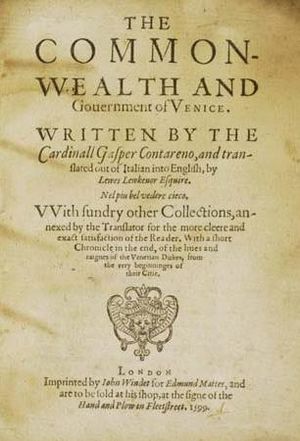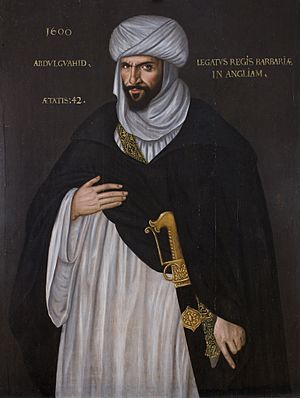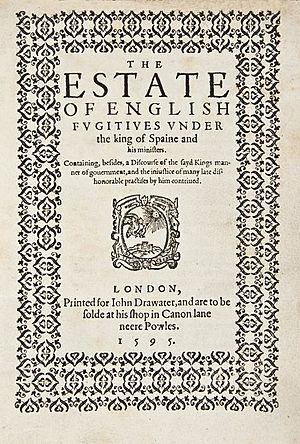Lewes Lewknor facts for kids
Quick facts for kids
Lewes Lewknor
|
|
|---|---|

The Commonwealth and Government of Venice "translated out of Italian into English by Lewes Lewkenor Esquire"
|
|
| Born | c.1560 Selsey, Sussex
|
| Died | 11 March 1627 |
| Education | Cambridge University Middle Temple |
| Occupation | soldier, lawyer, courtier, Member of Parliament, author, Master of the ceremonies, judge. |
| Known for | The Estate of English Fugitives The Commonwealth and Government of Venice |
Sir Lewes Lewknor (born around 1560, died 1627) was an important English gentleman who worked for the royal court. He was a writer, a soldier, and a judge. He is best known for being the Master of the Ceremonies for King James I of England. This job meant he was in charge of welcoming important visitors from other countries.
Lewes Lewknor was also a Member of Parliament (M.P.). He represented Midhurst in 1597 and Bridgnorth from 1604 to 1610. He was famous for translating books from other European languages into English. One very important translation was The Commonwealth and Government of Venice. This book was about how the city of Venice was run and it even influenced famous writers like William Shakespeare.
Lewknor also wrote his own book called The Estate of English Fugitives. In this book, he criticized Spain and some Catholic priests. But he also defended the rights of English Catholics.
Contents
Early Life and Career
Lewes Lewknor was the son of Thomas Lewknor and Bridget Lewes. He grew up in Tangmere and Selsey, England. He went to Cambridge University and then studied law at the Middle Temple. For a short time, he worked as a lawyer with his uncle, Richard.
In the 1580s, Lewknor lived in the Low Countries (modern-day Belgium and Netherlands). He was there because he was a Catholic, and at that time, Catholics faced difficulties in England. He tried to become a soldier and served as a captain in the Duke of Parma's army. However, he got a serious injury to his right arm.
By 1587, Lewknor was living in Antwerp with his wife. He faced money problems and decided to return to England. When he came back, he shared information with Lord Burghley about English Catholics who were working for Spain. He became a Member of Parliament for Midhurst in 1597. From 1599 to 1603, he worked as a Gentleman Pensioner. This was a group of gentlemen who served the Queen. After Queen Elizabeth died, he returned to practicing Catholicism.
Master of the Ceremonies Role
Lewknor became very good at understanding how royal ceremonies worked. As a Gentleman Pensioner, he was often asked to host important visitors from other countries. In 1600, he took care of the French ambassador, traveling with him from Dover to London. That same year, he also escorted the Moroccan ambassador, Abd el-Ouahed ben Messaoud. Some people think this ambassador might have inspired Shakespeare's play Othello.
When King James I became king in 1603, Lewknor's job became official. He was made a knight that year. He was given a brand new job called Master of the Ceremonies. For this important role, he earned £200 every year. His job was confirmed for his whole life in 1605. Lewknor spent most of his time looking after foreign visitors. For example, in 1603, he spoke Spanish for the King to the ambassador from Spain. In 1612, he met Frederick V of the Palatinate at Gravesend.
In 1615, records show his expenses for welcoming French, Polish, and Venetian ambassadors. Lewknor brought them to meet King James, Queen Anne, and Prince Charles. He even took the French and Venetian ambassadors hunting. He had an assistant named John Finet, who later took over his job.
Lewknor's Writings
Most of Lewknor's published works were translations of books from other European countries. He translated from French, Spanish, and Italian. He is also credited with introducing some new words into the English language, like "cashiering" (meaning to dismiss someone from a job) and "unnobly."
In 1594, Lewknor translated The Resolved Gentleman. This book was originally a French story about knights. Some people think Lewknor's translation was a clever way to criticize the English court in the 1590s. The book included poems by his friends, like Maurice Kyffin and Sir John Harington. In his introduction, Lewknor praised his university friend, Edmund Spenser, who wrote The Faerie Queene.
In 1595, his own book, A Discourse of the Usage of the English Fugitives, by the Spaniard, was published. It became very popular and was reprinted four times in two years. It was later expanded and renamed The Estate of English Fugitives under the king of Spaine and his ministers. This book told exciting stories about his time as a soldier in the Netherlands. It criticized Spain and some Catholic priests. He told English Catholics that some people were using religion as an excuse for their actions. Even though the book was signed with the initials "L.L.", it is now generally believed that Lewes Lewknor was the author.
His 1599 translation of The Commonwealth and Government of Venice showed how much Englishmen admired the way Venice was governed. Lewknor described Venice as a city blessed by both clever people and divine favor. This book influenced how Venice was shown in plays, especially Shakespeare's Othello and Ben Jonson's Volpone. The book also included extra information about Venice's history, geography, and customs.
Lewknor was also part of Prince Henry's group of friends. He wrote a funny poem called Old Wormy Age for the beginning of Thomas Coryat's travel book, Coryat's Crudities: Hastily gobbled up in Five Moneth’s Travels, which came out in 1611.
Family Life
Before 1588, while he was in the Spanish Netherlands, Lewes Lewknor married Beatrice de Rota. They had two sons, William and Thomas (who lived from 1587 to 1645), and a daughter named Beatrice. William was mentioned in a lease agreement in 1597. In 1606, William was in Angers, France, spending time with Jesuits.
Lewes's wife, Beatrice de Rota, died in March 1605 from smallpox. Lewes quickly married Katherine Argall, who was the widow of his cousin. Sadly, Katherine also died from smallpox within six months of their marriage. Finally, he married Mary Blount. In 1624, Lewknor and his wife were suspected of secretly practicing Catholicism.
In May 1624, Lewknor was held for some time in the Tower of London. This was because he ordered a ship for the Spanish ambassador without getting permission first.
After King James I's funeral, Lewknor was accused by the Venetian ambassador of purposely keeping him from the funeral. Lewknor said he was too sick, but he was still held for a while and suspended from his job. He was under house arrest for seven months until the Venetian ambassador changed his mind. Lewknor was then allowed to return to his post. Lewknor and his wife were accused two more times of being secret Catholics.
Lewknor's last official duty was on November 29, 1626. King Charles I sent him to attend a French ambassador. Lewknor died on March 11, 1627. His assistant, John Finet, then took over his job as Master of the Ceremonies. Lewknor's son Thomas outlived him, but Thomas became a Jesuit priest and did not have any children.
Images for kids






